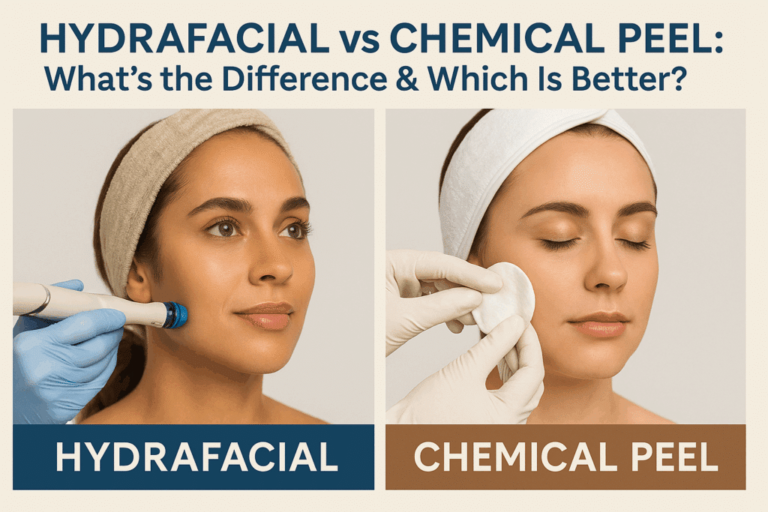When it comes to achieving glowing, healthy, and youthful-looking skin, two of the most popular professional treatments are the HydraFacial and the Chemical Peel. Both promise smoother texture, reduced blemishes, and radiant results — but they work in very different ways. If you’re wondering which treatment gives better results for your skin, this comparison will help you decide.
What Is a HydraFacial?
A Hydrafacial is a non-invasive, multi-step facial treatment that cleanses, exfoliates, and hydrates the skin. It uses a patented device with a vortex-like suction to remove dead skin cells and impurities while simultaneously infusing the skin with nourishing serums rich in antioxidants, peptides, and hyaluronic acid.
Key benefits of a Hydrafacial:
- Deeply cleanses pores without irritation
- Boosts hydration and gives an instant glow
- Reduces fine lines and wrinkles
- Improves elasticity and firmness
- Suitable for all skin types, even sensitive skin
Hydrafacials are gentle, quick (usually 30–45 minutes), and require no downtime, making them perfect for anyone looking for instant radiance before an event or as part of a regular skincare routine.
What Is a Chemical Peel?
A Chemical Peel is a skin-resurfacing treatment that uses chemical solutions such as glycolic acid, lactic acid, or trichloroacetic acid to exfoliate the top layers of skin. The strength of the peel can be superficial, medium, or deep, depending on your skin’s needs.
Key benefits of a Chemical Peel:
- Reduces acne scars and hyperpigmentation
- Smooths rough skin texture
- Minimizes fine lines and wrinkles
- Stimulates collagen production
- Improves overall skin tone and brightness
However, unlike a Hydrafacial, a chemical peel often involves some downtime — mild redness or peeling may occur for a few days as your skin renews itself.
Hydrafacial vs Chemical Peel: The Key Differences
| Feature | Hydrafacial | Chemical Peel |
|---|---|---|
| Procedure | Uses suction and serums to cleanse and hydrate | Uses acids to exfoliate outer skin layers |
| Downtime | None | 1–7 days depending on peel strength |
| Comfort | Gentle and relaxing | Slight tingling or stinging sensation |
| Results | Instant glow and hydration | Deeper resurfacing and long-term skin renewal |
| Ideal For | Sensitive, dry, or dull skin | Acne-prone, scarred, or sun-damaged skin |
Which Treatment Gives Better Results?
The answer depends on your skin goals and condition.
- If you want instant glow and hydration with no downtime, go for a Hydrafacial. It’s perfect for maintaining healthy skin and can be done monthly.
- If you want to treat deeper skin concerns like acne scars, fine lines, or hyperpigmentation, a Chemical Peel may deliver more dramatic results.
Many skincare experts even recommend combining both treatments — using Hydrafacials for regular upkeep and Chemical Peels a few times a year for deeper renewal.
Which Is Safer for Sensitive Skin?
Hydrafacials are generally safer for sensitive skin because they are customizable and non-irritating. Chemical peels, especially medium or deep ones, should only be performed under professional supervision and might not be suitable for those with very sensitive or reactive skin.
Final Verdict
Both Hydrafacial and Chemical Peel treatments can dramatically improve your skin’s texture, clarity, and radiance.
If you’re new to advanced skincare treatments, start with a Hydrafacial for a gentle introduction.
If you’re targeting specific issues like scars or pigmentation, a Chemical Peel can help you achieve deeper, long-lasting transformation.
For the best results, consult with a licensed aesthetician or dermatologist who can analyze your skin and recommend the right treatment plan for your needs.

